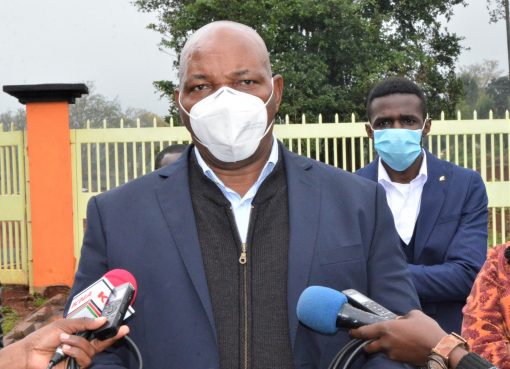The national and county governments in partnership with development partners have rolled out a disease control and eradication strategy against Peste des Petits Ruminantes (PPR) in the country.
The government will carry out mass vaccination of sheep and goats which are adversely affected by frequent droughts and attacks of the disease, in effect undermining food and nutrition security especially in the ASAL areas.
PPR is a highly contagious viral disease that has been a major cause of death among small ruminants.
According to the Cabinet Secretary Ministry of Agriculture, Livestock, Fisheries and Irrigation Mr. Mwangi Kiunjuri, outbreak of this disease between 2006 and 2008 was responsible for the death of at least 1.2 million goats and sheep and the country lost an estimated sh24 billion.
Addressing members of public at the Isiolo livestock Market when he presided over the roll out of the programme Saturday, Kiunjuri said that the government had set an ambitious goal to eradicate the disease before year 2027, with the rest of the world expected to achieve it by the year 2030.
Kiunjuri said the viral disease will be combated through mass vaccination exercise to be conducted in the 14 most susceptible Asal counties of Isiolo, Marsabit, Samburu, Mandera, Wajir, Garissa, Tana River, Turkana, West Pokot, Baringo, Marakwet, Laikipia, Narok and Kajiado Counties.
The CS said that the government had set aside Sh200 million to roll out the programme, but warned that there was need for concerted efforts between neighbouring counties to also carry out a similar strategy since the disease was trans-boundary, and animals move freely between Kenya and neighbouring countries.
“It is important to note that a significant proportion of Kenya’s sheep and goats are mostly found in the Arid and Semi-Arid Lands (ASALs) parts of our country. Due to their low purchase price and production cost, they are popular with farmers as sources of food and quick household income,” he said.
Kiunjuri said to support the economies of the ASAL regions, the ministry in cooperation with the concerned County Governments will work together to eradicate PPR by 2027.
Isiolo governor Mohamed Kuti acknowledged presence of the disease in the region, with local pastoralists losing thousands of animals to it.
He asked farmers to be close to the livestock officers from the directorate of veterinary services and ensure they present their goats and sheep for the mass vaccination exercise, in order to ensure that the eradication strategy is successful.
Laikipia governor Ndiritu Muriithi urged the farmers to use modern methods, where small pieces of land can be used to hold a big number of animals while the rest of the land is used to produce fodder for the animals.
He argued that managing animals within localized pasture ranges would reduce spread of livestock diseases and also improve production of meat and milk.
Muriithi asked businessmen from the area to establish tanneries locally and advance to value addition of the animals’ products like hides and skin from which they can make leather shoes and earn better returns.
The disease also known as goat plague, ‘sotoka ya mbuzi na kondoo’ in Kiswahili or ‘Lomoo’ locally is viral and characterized by diarhoea, nasal discharge and sore eyes, and is spread through close contact.
By David Nduro




